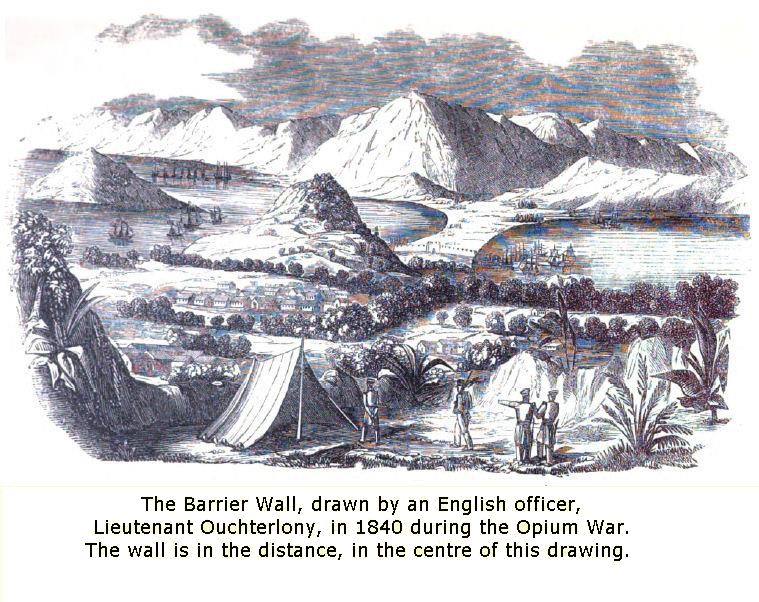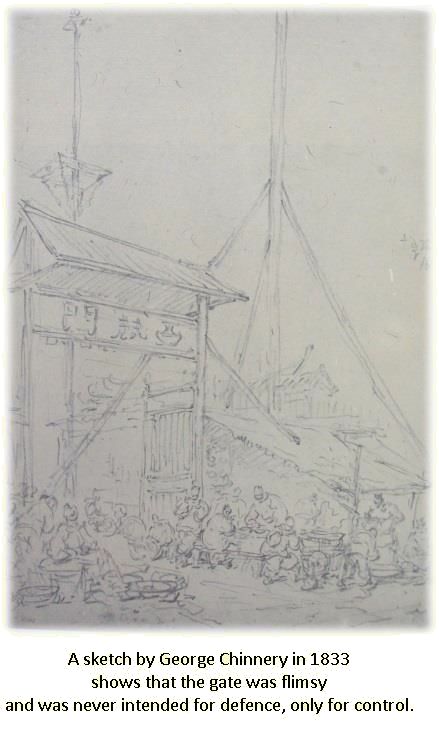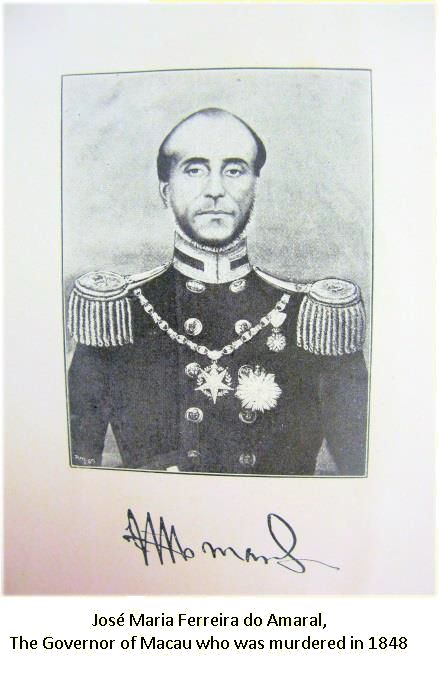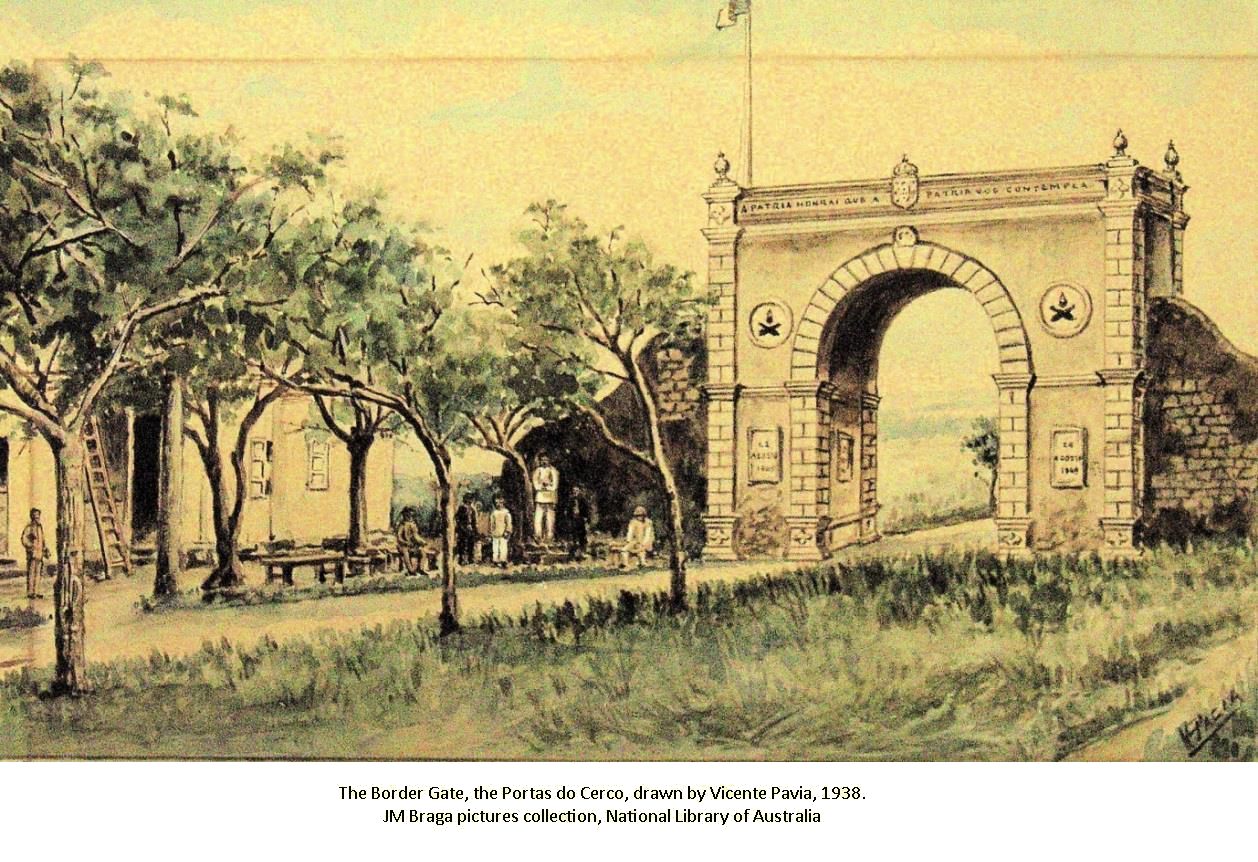The Border Gate, or Portas do Cerco
The boundary between Macau and what is commonly called the Mainland is now defined by tall buildings and a well-organised border post, some 3 km from the centre of Macau. In the middle of these modern buildings there is an old-fashioned arch erected in 1870 as a triumphal statement of Portugal's victory over China 21 years earlier. However for most of the previous three centuries, the boot was on the other foot. In 1573, sixteen years after the Portuguese arrived in Macau, the Chinese authorities on Heung Shan Island, of which Macau is a part, decided that these strange people whom they termed Western Barbarians must be kept under control. In China, as in Europe at that time, this meant building a wall. Therefore a wall was hastily constructed across the narrowest point of the small peninsula on which the Portuguese had settled. Now known as the Border Gate, it was then the Barrier Wall, with only one gate. What did this mean?
Did it mean that the Chinese Empire had given this land to Portugal? On the other hand, was this the first stage of a siege at the end of which the Portuguese might be pushed out or exterminated, which is what the Japanese did in 1640 to the members of a Portuguese embassy seeking to re-establish trade with Japan? Neither of these is true. It seems to have been an ad hoc measure to control both the people in Macau and those who came to trade with them. This trade was essential, because Macau was a barren, rocky outcrop unable to grow its own food, and even supplies of fresh water were precarious.
Each week a market was held on the south side of the gate through which Chinese traders, chiefly vegetable growers, were allowed to enter a small area of land marked out as a market place. After a few hours, the traders were sent back and the gate was closed until the following week. Above the gate was an inscription on the Portuguese side, 'Western Barbarian Gate' and there were two signs instructing the Portuguese 'dread our greatness' and 'respect our virtue'. The implied menace is obvious. To ensure that all requirements were observed, the Heung Shan Mandarin erected a compound on high ground some distance away from the wall. It was painted white so that it could not be ignored, and was termed by the Portuguese the Casa Branca, the White House.
Almost the only time Portuguese people were allowed on the northern side of the gate was when a delegation from the Council of Macau, the Leal Senado, came with some special request or to pay an annual rent amounting to $500. They were obliged to make obeisance, the infamous kow tow, to the mandarin. A visiting Spanish Dominican friar, Domingo Navarrete, writing in 1672, saw what happened.
They go in a body with rods in their hands to the Mandarine who resides a League from hence and they petition him on their Knees. The Mandarine in his Answer writes thus: 'This barbarous and brutal People desires such and such a thing: let it be granted.' Or 'refus'd them.' ... if their King knew of these things it is almost incredible that he should allow of them.1
The kow tow was a humiliating grovel and when King João V of Portugal heard about it in 1712, he forbade his subjects to perform it. However, Lisbon was 11,000 km away, and the people in Macau had no option but to do as the mandarin demanded.
If something happened to displease the magistrate, the gate was shut and the weekly market closed until Macau submitted to his will; the mere threat was usually sufficient, but in 1662, the gate was closed for three months and many people starved to death. There was no other way of bringing food in. Why did the Portuguese not attack the wall and force the Chinese to submit? The answer is that the fortifications of Macau, which seem quite impressive to the modern visitor, were only defensive and there was no capacity to attack.
From the Chinese point of view, it served its purpose well until the Opium War, 1839-1842. The British defeated the Chinese who were then in no position to dictate terms to the Portuguese as they had done for more than 250 years. A few years later, in 1847, the Governor of Macau, João Maria Ferreira do Amaral, rejecting Chinese suzerainty over Macau, refused to pay the annual rent.
Tensions ran high, until on 22 August 1849, Amaral was set upon, killed and beheaded by a group of Chinese in what amounted to No Man's Land between Macau's city wall and the barrier wall further to the north. There was a swift reaction, and for the first time in the history of Macau, the Portuguese did attack the Chinese, who had been greatly weakened by their defeat in the Opium War some years earlier. Three days after the death of Amaral, Lieutenant Vicente Nicolau Mesquita led an heroic charge which captured the Chinese fort north of the barrier wall.2 That was the end of the old Barrier Gate with all its connotations of subjugation. 21 years later the Portas do Cerco was built. It looks very much like a Roman triumphal arch and this was indeed the intention.
At the top of the arch is inscribed a famous quotation from the great Portuguese poet Luís de Camões: 'A pátria honrai, que a pátria vos contempla' ('Honour your country, for your country looks after you'). On the walls of the arch were tablets, one bearing the date of Governor Amaral's death and the other, the heroic charge of Mesquita, who avenged his death.
Two more plaques bear the dates when the arch was commenced and completed: 22 August 1870, the 21st anniversary of Amaral's murder, and the date of the arch's completion, 31 October 1871. A further adornment is a series of azulejos, lovely Portuguese blue tiles celebrating the achievements of Portuguese exploration over the previous 400 years.
A century after Amaral's murder, the frontier was closed once again. For many years after the Chinese Revolution in 1949, the Portas do Cerco was a no-go area. Only local people bringing farm produce to sell in Macau were permitted to cross. Sir Lindsay Ride, the Vice-Chancellor of Hong Kong University, who took a keen interest in the history of Macau, was not allowed to go there to look at the inscriptions. In 1952 there was a major border incident when Portuguese African troops exchanged fire with Chinese border guards. The exchange lasted for more than an hour, leaving one dead and several dozens injured on the Macau side and an unknown number of casualties on the Chinese side. After the death of Chairman Mao, tensions relaxed and the border gradually reopened.
Now, in the 21st century, all the statements asserting or denying sovereignty and conquest can be set aside. Macau is no longer terrorised by Chinese mandarins, while the Chinese no longer feel humiliated by the boastful arch built to proclaim their defeat at the hands of the Portuguese. Where once local farmers selling vegetables, pigs and poultry were allowed through the barrier gate once a week, up to 50,000 tourists now come from the mainland each day to gamble in Macau's casinos. However, the old arch remains as a reminder of an era when times were more difficult and attitudes far less friendly.
2 Click to read an article on Amaral and Mesquita.



